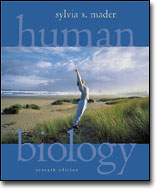|
 |  Human Biology, 7/e Dr. Sylvia S. Mader
Chemistry of Life
Chapter Outline
2.1 Elements and AtomsAll matter is composed of elements, each having one type of atom. 16 |
 |  |  | 2.2 Molecules and CompoundsAtoms react with one another, forming ions, molecules, and compounds. 19 |
 |  |  | 2.3 Water and Living ThingsThe existence of living things is dependent on the characteristics of water. 21The hydrogen ion concentration in water changes when acids or bases are added to water. 23 |
 |  |  | 2.4 Molecules of LifeMacromolecules are polymers that arise when their specific monomers (unit molecules) join together. 26The molecules found in cells are carbohydrates, lipids, proteins, and nucleic acids. 26 |
 |  |  | 2.5 CarbohydratesCarbohydrates function as a ready source of energy in most organisms. 27Glucose is a simple sugar; starch, glycogen, and cellulose are polymers of glucose. 27Cellulose lends structural support to plant cell walls. 28 |
 |  |  | 2.6 LipidsLipids are varied molecules. 29Fats and oils, which function in long-term energy storage, are composed of glycerol and three fatty acids. 29Sex hormones are derived from cholesterol, a complex ring compound. 30 |
 |  |  | 2.7 ProteinsProteins help form structures (e.g., muscles and membranes) and function as enzymes. 31Proteins are polymers of amino acids. 32 |
 |  |  | 2.8 Nucleic AcidsNucleic acids are polymers of nucleotides. 35Genes are composed of DNA. RNA serves as an intermediary during protein synthesis. 35 |
|
|



 2002 McGraw-Hill Higher Education
2002 McGraw-Hill Higher Education

 2002 McGraw-Hill Higher Education
2002 McGraw-Hill Higher Education